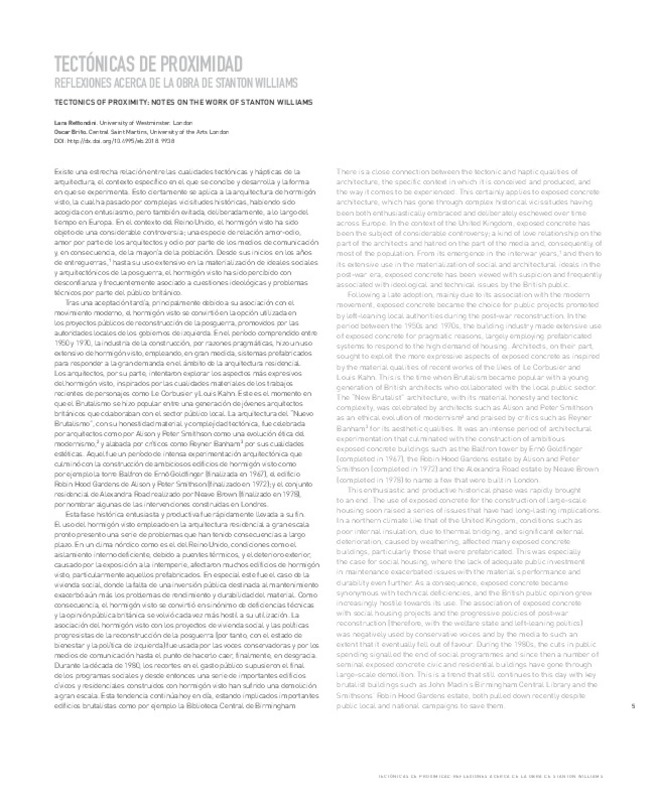JavaScript is disabled for your browser. Some features of this site may not work without it.
Buscar en RiuNet
Listar
Mi cuenta
Estadísticas
Ayuda RiuNet
Admin. UPV
Tectónicas de proximidad: reflexiones acerca de la obra de Stanton Williams
Mostrar el registro sencillo del ítem
Ficheros en el ítem
| dc.contributor.author | Rettondini, Lara
|
es_ES |
| dc.contributor.author | Brito, Oscar
|
es_ES |
| dc.date.accessioned | 2018-05-02T08:04:36Z | |
| dc.date.available | 2018-05-02T08:04:36Z | |
| dc.date.issued | 2018-04-30 | |
| dc.identifier.issn | 1888-5616 | |
| dc.identifier.uri | http://hdl.handle.net/10251/101186 | |
| dc.description.abstract | [EN] The method of layering materials is the more noticeable in the work of Stanton Williams. To obtain a cohesive ensemble, they combine exposed concrete with a carefully selected stratum of ‘noble’ materials including stone, as in the Sainsbury Laboratory, or timber, as in the Britten-Pears Archive. This considered juxtaposition allows them to establish a serious dialogue between materials that enhances their inherent qualities, something that the practice indicate as fundamental to the way in which their buildings are perceived. By carving, folding and layering, Stanton Williams aim to intensify the production of a tectonic experience at multiple scales, which goes from an overall awareness of totality to a closer appreciation of details and finishes. And it is precisely this that ultimately reveals the phenomenological relationship between body, space and building, where the human experience in architecture is mediated via tectonics of proximity. | es_ES |
| dc.description.abstract | [ES] El método de estratificar materiales es el más evidente en el trabajo de Stanton Williams. Para obtener un conjunto cohesivo, combinan el hormigón visto con un estrato cuidadosamente seleccionado de materiales "nobles", incluida la piedra, como en el Sainsbury Laboratory, o la madera, como en el Britten-Pears Archive. Esta considerada yuxtaposición les permite establecer un serio diálogo entre los materiales, el cual mejora sus cualidades inherentes, algo que el estudio indica como fundamental a la manera en la cual sus edificios son percibidos. Al tallar, plegar y estratificar, Stanton Williams tiene como objetivo intensificar la producción de una experiencia tectónica en múltiples escalas, que va desde una conciencia general de la totalidad hasta una apreciación más cercana de los detalles y los acabados. Y es precisamente este hecho lo que finalmente revela la relación fenomenológica entre cuerpo, espacio y construcción, donde la experiencia humana en arquitectura está mediada por la tectónica de la proximidad. | es_ES |
| dc.language | Español | es_ES |
| dc.language | Inglés | es_ES |
| dc.publisher | Universitat Politècnica de València | |
| dc.relation.ispartof | EN BLANCO. Revista de Arquitectura | |
| dc.rights | Reconocimiento - No comercial (by-nc) | es_ES |
| dc.subject | Tectónica de Proximidad | es_ES |
| dc.subject | Reflexiones | es_ES |
| dc.subject | Stanton Williams | es_ES |
| dc.subject | Tectonics of Proximity | es_ES |
| dc.subject | Notes | es_ES |
| dc.title | Tectónicas de proximidad: reflexiones acerca de la obra de Stanton Williams | es_ES |
| dc.title.alternative | Tectonic of proximity: notes on the work of Stanton Williams | es_ES |
| dc.type | Artículo | es_ES |
| dc.date.updated | 2018-05-02T07:56:29Z | |
| dc.identifier.doi | 10.4995/eb.2018.9938 | |
| dc.rights.accessRights | Abierto | es_ES |
| dc.description.bibliographicCitation | Rettondini, L.; Brito, O. (2018). Tectónicas de proximidad: reflexiones acerca de la obra de Stanton Williams. EN BLANCO. Revista de Arquitectura. 10(24):5-7. https://doi.org/10.4995/eb.2018.9938 | es_ES |
| dc.description.accrualMethod | SWORD | es_ES |
| dc.relation.publisherversion | https://doi.org/10.4995/eb.2018.9938 | es_ES |
| dc.description.upvformatpinicio | 5 | es_ES |
| dc.description.upvformatpfin | 7 | es_ES |
| dc.type.version | info:eu-repo/semantics/publishedVersion | es_ES |
| dc.description.volume | 10 | |
| dc.description.issue | 24 | |
| dc.identifier.eissn | 2445-1215 |








